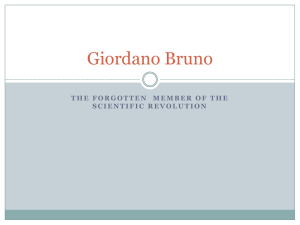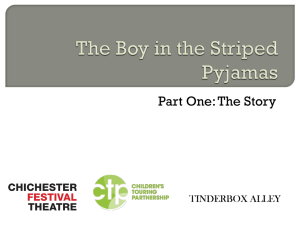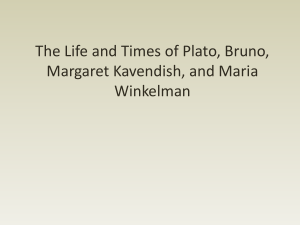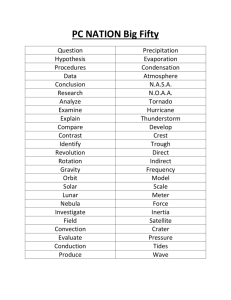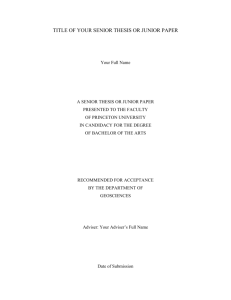GB paper
advertisement
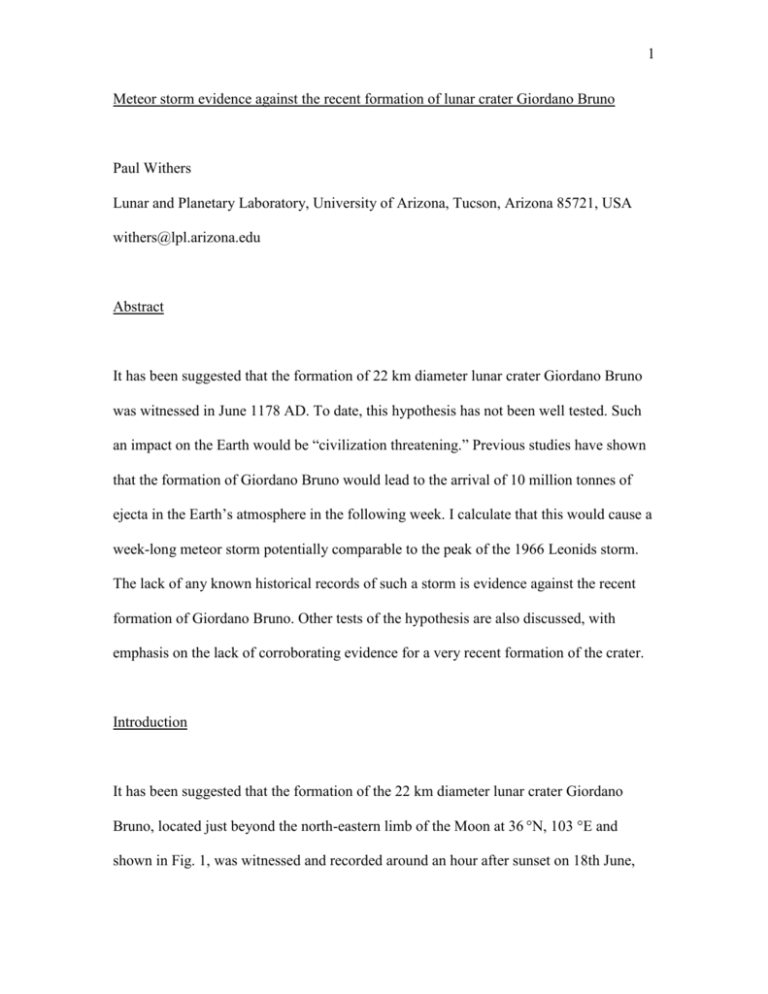
1 Meteor storm evidence against the recent formation of lunar crater Giordano Bruno Paul Withers Lunar and Planetary Laboratory, University of Arizona, Tucson, Arizona 85721, USA withers@lpl.arizona.edu Abstract It has been suggested that the formation of 22 km diameter lunar crater Giordano Bruno was witnessed in June 1178 AD. To date, this hypothesis has not been well tested. Such an impact on the Earth would be “civilization threatening.” Previous studies have shown that the formation of Giordano Bruno would lead to the arrival of 10 million tonnes of ejecta in the Earth’s atmosphere in the following week. I calculate that this would cause a week-long meteor storm potentially comparable to the peak of the 1966 Leonids storm. The lack of any known historical records of such a storm is evidence against the recent formation of Giordano Bruno. Other tests of the hypothesis are also discussed, with emphasis on the lack of corroborating evidence for a very recent formation of the crater. Introduction It has been suggested that the formation of the 22 km diameter lunar crater Giordano Bruno, located just beyond the north-eastern limb of the Moon at 36 °N, 103 °E and shown in Fig. 1, was witnessed and recorded around an hour after sunset on 18th June, 2 1178 AD in the Julian calendar (Hartung, 1976, date corrected in Calame and Mulholland, 1978). A dramatic passage in the medieval chronicles of Gervase of Canterbury speaks of the crescent Moon “spewing out fire, hot coals, and sparks,” a potentially plausible description of an impact on the Moon. An English translation of the relevant passage can be found in Hartung (1976) and the original Latin in Stubbs (1879). The chronicle itself resides in the library of Trinity College, Cambridge, Great Britain, with catalogue number MS R.4.11. Based on its extensive pattern of bright rays and uneroded morphology, Giordano Bruno is the youngest lunar crater of its size or larger (Hartung, 1976). Its position close to the north-eastern limb of the Moon is consistent with some details in the passage, and this and its youth led Hartung to suggest it as the impact site. Following Holsapple, 1993, the impactor would have been of size 1 – 3 km, assuming impact velocities of 70 – 5 km s-1 respectively. Such an impact on the Earth would be “civilization threatening” (Lissauer, 1999) and have a value on the Torino Scale of 9 – 10, corresponding to regional devastation to global climatic catastrophe (Binzel, 1999). The Torino Scale gauges the potential damage that may occur in the event of an impact of an asteroid, or other object from space, on the Earth, just as the Richter Scale gauges earthquake damage. Therefore it is important to test Hartung’s hypothesis that such an event happened on the Moon less than a millenium ago. This hypothesis was strongly opposed by Nininger and Huss (1977), who offered a careful rebuttal of many of Hartung’s lines of evidence. They concluded that the passage 3 was inconsistent with a lunar impact and suggested that it was a report of a meteor in transit of the Moon. Apart from turbulence in the atmosphere (Hartung, 1976), no other interpretations of the passage have been suggested in the scientific literature. Nininger and Huss’s rebuttal failed to completely disprove Hartung’s hypothesis in the eyes of many. As an intriguing, improbable idea, Hartung’s hypothesis has appeared in the peer-reviewed scientific literature (including Saul and Lawniczak, 1996; Pieters et al, 1994; Hartung, 1993a, Hartung, 1993b; Harris, 1993; Gault and Schultz, 1991; Oberst, 1989; Hartung, 1987; Yoder, 1981; Hughes, 1981; Baldwin, 1981; Calame and Mulholland, 1978; Nininger and Huss, 1977; Hughes, 1976) and well-known popular science literature such as Cosmos (Sagan, 1980) and Rain of Iron and Ice (Lewis, 1996). The hypothesis has also been connected to the Tunguska event of 1908 (Hartung, 1993b) and the decline of certain Pacific civilizations (Spedicato, 1997). Hartung’s hypothesis has proven difficult to test over the years, as data from the region of the Moon surrounding Giordano Bruno is of low quality (Pieters et al, 1994). In an attempt to explain unexpectedly large amplitudes of free libration of the Moon, a partial lunar laser ranging dataset was interpreted to be consistent with Hartung’s hypothesis and was published on the front cover of Science (Calame and Mulholland, 1978). A later analysis of a more complete dataset suggested that Hartung’s hypothesis could not explain the large free librations and proposed turbulent core-mantle friction as their source (Yoder, 1981). 4 Meteor Storm The general fate of the ejecta from lunar impacts has been discussed in the literature (Gladman et al, 1996; Gladman et al, 1995; Gault, 1983) – as has the specific case of Giordano Bruno ejecta (Hartung, 1993a; Hartung, 1993b; Harris, 1993; Gault and Schultz, 1991; Mims and James, 1982; Hartung, 1981), but the resultant meteor storm has not been described in the peer-reviewed literature. In a conference abstract, Mims and James (1982) sketch a single direct trajectory, with a daytime arrival at the Earth. They do not appear to have calculated terrestrial arrival times for general direct trajectories, and have not published the work described in the conference abstract in the peerreviewed literature. Gault and Schultz (1991) state that the Earth would have accreted 1013 grams of ejecta, travelling on direct trajectories with a characteristic entry speed of at least the Earth’s escape velocity (11.2 km s-1), in the week after the formation of Giordano Bruno. Gault’s work on the dynamics of lunar impact ejecta is consistent with currently authoritative work (Gladman et al, 1995). No statements are made about local day or night-time arrivals of the ejecta on the Earth, but, given the large range in initial speed and direction of the ejecta, it seems reasonable that at least a portion of the subsequent meteor storm would have been visible during night-time. This work calculates the properties of that meteor storm. The size distribution of the ejecta is uncertain. Power-law distributions for ejecta sizes, with the cumulative number of fragments of mass greater than m approximately inversely proportional to m, have been used in discussions of ejecta deposits. However, such a 5 distribution is not necessarily appropriate here. As discussed by Melosh, 1989, it applies to the ejecta deposits taken as a whole, whereas the current problem is concerned only with that fraction of the ejecta that reaches lunar escape velocity. Ejecta from the Ries Crater in Germany clearly shows a dependence of ejecta size on distance from the crater, and hence on ejection speed (Horz et al, 1983). In a study of secondary craters on the Moon, Mercury, and Mars, Vickery (1987) showed that the size of the largest fragment ejected at a given speed is approximately inversely proportional to the square of that speed. The constant of proportionality may depend on impactor size, velocity, and material. For the Giordano Bruno case, it is not directly predictable from Vickery's work. However, a value of 106 m-1 s2 is consistent with her work. This suggests that no fragments larger in radius than 10 cm reach lunar escape velocity. A minimum fragment radius of 0.1 cm is suggested by Melosh and Vickery (1991). Rather than compounding uncertainties by requiring a range of sizes according to some distribution, I shall assume that all fragments reaching Earth are the same size. I shall later show that this assumption does not affect my conclusions. Mass-velocity-magnitude relations for meteors are uncertain (Jenniskens et al., 1998). Jenniskens et al use a relationship from Jacchia et al (1967): log M (g) = 6.06 - 0.62 mvis - 3.89 log V° (km/s) - 0.67 log (sin(hr)) (1) with M the mass, hr the radiant altitude, V° the apparent velocity and mvis the visible magnitude of the meteor. Consider fragments with a characteristic radius of 1 cm and a 6 typical silicate density of 2.5 g cm-3, giving a characteristic mass of 10 g. Taking hr as 45°, V° as 11.2 km s-1, and M as 10 g results in a visible magnitude of 1.7 and total number of meteors of 1012, where the total mass has been constrained by Gault and Schultz (1991) to be 1013 g. A uniform distribution over the surface of the Earth and the week-long interval corresponds to a rate of 103 meteors km-2 hr-1. Taking the meteors to be visible at an altitude of 70 km or above (Greenhow and Hall, 1960), an observer viewing within 30° of zenith would see 5 x 104 meteors per hour. For comparison, the greatest meteor storm in living memory, the 1966 Leonids, had a zenith hourly rate of ~1.5 x 105 for 20 minutes over the western United States (Kronk, 1988) and typical background rates are a few per hour, with seasonal and diurnal variability of factors of a few (Shirley, 1997). If the characteristic radius of the ejecta is allowed to vary between the extremes of 0.1 and 10 cm, the magnitudes and numbers of meteors changes correspondingly, as shown in Fig. 2. The predicted range of meteor fluxes and magnitudes is large, but is not a critical problem for visibility of the meteor storm. At one extreme, the meteor storm is composed of very many faint meteors, and at the other, of many bright meteors. For the smallest reasonable characteristic ejecta radius, a hourly rate of 108 and some allowance for variability about the characteristic radius may be invoked to ensure that some of the meteors are brighter than magnitude 6. For any reasonable characteristic ejecta radius, the meteor storm is exceptional. It is apparent that any reasonable size distribution between the two extremes of 0.1 and 10 cm will produce an exceptional meteor storm. A meteor storm as impressive as this and lasting for a week would have been considered apocalyptic by all medieval observers. Any historical source from this time that mentions any astronomical phenomena whatsoever would have 7 recorded this event. Neither European (Dall’olmo, 1978), Arab (Rada and Stephenson, 1992), Chinese (Zhuang, 1977, Imoto and Hasegawa, 1958), Korean (Imoto and Hasegawa, 1958), nor Japanese (Imoto and Hasegawa, 1958) sources record a storm at this time, though they do qualitatively describe many others. In such reports, large numbers of meteors are typically described as “many” or “countless”, and bright meteors as “great stars” or “balls of fire.” The qualitative nature of these descriptions makes estimates of hourly rates or magnitudes difficult, and hence quantitative comparison between the recorded storms of antiquity and the predicted Giordano Bruno storm is also difficult. There is room for debate on the precise size of the meteor storm created by the hypothesised formation of Giordano Bruno 800 years ago. However, as shown in Fig. 2, it seems clear that it would have been a magnificent spectacle, worthy of chroniclers’ attention, visible over much of the world. The lack of records of such a meteor storm is strong evidence against Hartung’s hypothesis. Only one record of a meteor storm has ever been suggested as being the arrival of Giordano Bruno ejecta. This is a Korean report stating that “countless stars flew west” a few months after the proposed formation of Giordano Bruno (Mims and James, 1982). Other Tests of Hartung’s Hypothesis There are other ways in which Hartung’s hypothesis can be tested. Analysis of the best current imagery, such as Apollo 16 metric frame 3008, shown in Fig. 3, reveals only that 8 there are no craters of 1 km diameter or larger on the floor or ejecta blanket of Giordano Bruno out to one crater diameter from the rim, an area of approximately 3400 km2. The lunar cratering rate as a function of time is given by (Neukum and Ivanov, 1994): N(1) = 5.44 10-14 [exp(6.93 t) –1] + 8.38 10-4 t (2) where N(1) is the cumulative crater frequency per km2 at a crater diameter of 1 km and t is the age in billions of years. This constrains Giordano Bruno to be less than 350 million years old, which in itself does not prove or disprove Hartung’s hypothesis. However, assuming that cumulative crater frequency scales inversely with the square of crater diameter, equation (2) predicts the expected interval between Giordano Bruno-like cratering events on the Moon to be ~ 15 million years, making the formation of Giordano Bruno in historical times an extremely unlikely event (Neukum and Ivanov, 1994). According to Hartung’s hypothesis, this event should have been visible over a sizeable fraction of Western Europe, full of scholars ready to note such celestial happenings (Hartung, 1976). For example, in the English records, both a chronicler in nearby London and Gervase note a solar eclipse a mere three months later. The London chronicle has no mention of any impacts on the Moon. A number of French records also note the solar eclipse but not any impacts on the Moon (Newton, 1972). Maybe only Canterbury had clear skies that night. However, Gervase mentions only five witnesses, seated together, to the event. It is improbable that a lunar impact, as described in the passage, would be witnessed by only five people in the Canterbury region. However, for an observer to see a 9 meteor appear directly in front of the Moon requires the observer to be in a 1 kilometre diameter footprint on the Earth. Such a small footprint may help explain the paucity of witnesses so soon after sunset on a summer’s evening. A more serious problem is found in the reported date of the event, 18th June, 1178 AD in the Julian calendar. Contrary to earlier expectations, the 1.3 day old Moon would not have been visible on this date (Meuss, 1990; Schaefer, 1990). It would have been visible on the next and later days. It is possible that Gervase or his witnesses are in error about the date, but Gervase gives the correct date for the solar eclipse three months later (Newton, 1972) and the passage refers to the date as “the Sunday before the Feast of St. John the Baptist.” In an era of regular Sunday church attendance, it may be assumed that a witness would not confuse Sunday and any other day of the week. It seems to be generally agreed that this Sunday was the 18th June. According to Waddington (Hartung, 1993b) “Hoc anno, die Dominica ante Nativitatem Sancti Johannis Baptistae” may actually translate as the day after the Sunday in question, or 19th June, thus fixing all date-related problems. I have not yet seen any evidence to support this unusual assertion. This date problem also poses problems for the meteor interpretation of the passage, and is probably best used as evidence for unreliability in the source. The search for a surface temperature anomaly suggested by Hartung (1976) seems unrealistic in view of the observed rapid cooling and solidification of the surface of terrestrial kilometre-thick lava lake, Kilauea-Iki (Hardee, 1980). A simple terrestrial cooling model, adapted for the Moon, suggests that no surface temperature anomaly would remain after a decade (Keszthelyi and Denlinger, 2000). 10 Radiometric studies of Giordano Bruno material would definitively date its formation. The Soviet Luna 24 sample return mission landed close to a Giordano Bruno ray but unfortunately is not believed to have returned any Giordano Bruno ejecta (Maxwell and El-Baz, 1978). It has been suggested that a lunar meteorite, ALHA 81005, may originate from Giordano Bruno, though the evidence supporting this claim is not strong (Ryder and Ostertag, 1983). ALHA 81005 was ejected from the Moon approximately 10,000 years ago (Warren, 1994). Studies of the spectral maturation of lunar crater ejecta have been used to constrain crater ages with respect to radiometrically dated large craters and suggest that Giordano Bruno is younger than 100 million years old (Grier, 1999). Work is proceeding to include radiometrically dated smaller, younger craters in the calibration, which may drive down this upper age limit (Grier et al, 2000). High resolution Clementine images show evidence of weathering in Giordano Bruno suggesting “that either Giordano Bruno is substantially older than 800 years old, or that the weathering process on the Moon is far more rapid than currently expected.” (Pieters et al, 1994). There are also a number of reasons why Gervase’s chronicle should not be interpreted as describing a lunar impact, many of which are detailed in Nininger and Huss (1977). Briefly summarized, Nininger and Huss considered the dynamic and repeatable events 11 described in Gervase’s chronicle, including the differentiation of “fire, hot coals, and sparks” near the Moon from one another by witnesses on the surface of the Earth, to be inconsistent with Hartung’s hypothesis. Conclusions It has been suggested that the formation of 22 km diameter lunar crater Giordano Bruno was witnessed in June 1178 AD. There is no strong evidence to support this hypothesis. Strong evidence against this hypothesis is provided by Nininger and Huss (1977) and by the current paper. Nininger and Huss suggest that the medieval text upon which the hypothesis is based is inconsistent with the hypothesis. The current paper predicts a superlative meteor storm in the week after Giordano Bruno’s formation. No records of such a storm have been found, suggesting that no such storm occurred in June 1178 AD, and hence that Giordano Bruno did not form at this time. Acknowledgements A. E. Bernstein, W. Bottke, J. A. Grier, L. L. Hood, L. Keszthelyi, J. S. Lewis, H. J. Melosh, E. Pierazzo, B. E. Schaefer, M. Schuchardt, T. Swindle, and an anonymous reviewer. References 12 BALDWIN R. B. (1981) Tektites – Size estimates of their source craters and implications for their origin. Icarus 45, 554-563. BINZEL R. P. (1999) Assessing the hazard: The development of the Torino Scale. The Planetary Report XIX, number 6, 6-10. CALAME O. AND MULHOLLAND J. D. (1978) Lunar crater Giordano Bruno: AD 1178 impact observations consistent with laser ranging results. Science 199, 875-877. DALL’OLMO U. (1978) Meteors, meteor showers and meteorites in the Middle Ages: from European medieval sources. Journal for the History of Astronomy 9, 123-134. GAULT D. E. (1983) The terrestrial accretion of lunar material. Proc. Lunar Planet. Sci. Conf. 14th, 243-244. GAULT D. E. AND SCHULTZ P. H. (1991) Ejecta from lunar impacts: Where is it on Earth? Meteoritics 26, 336-337. GLADMAN B. J., BURNS J. A., DUNCAN M. J. AND LEVISON H. F. (1995) The dynamical evolution of lunar impact ejecta. Icarus 118, 302-321. GLADMAN B. J., BURNS J. A., DUNCAN M. J., LEE P. AND LEVISON H. F. (1996) The exchange of impact ejecta between terrestrial planets. Science 271, 1387-1392. GREENHOW J. S. AND HALL J. E. (1960) The variation of meteor heights with velocity and magnitude. Mon. Not. R. Astron. Soc. 121, 174-182. GRIER J. A. (1999) PhD. thesis, University of Arizona, Tucson, Arizona, USA. GRIER J. A., MCEWEN A. S., MILAZZO M., HESTER J. A., AND LUCEY P. G. (2000) The optical maturity of the ejecta of small bright rayed lunar craters. Proc. Lunar Planet. Sci. Conf. 31st, 1950. 13 HARDEE H. C. (1980) Solidification in Kilauea-Iki lava lake. J. Volcanology and Geothermal Res. 7, 211-223. HARRIS A. W. Corvid meteoroids are not ejecta from the Giordano Bruno impact. J. Geophys. Res. 98, 9145-9149. HARTUNG. J. B. (1976) Was the formation of a 20-km diameter impact crater on the Moon observed on June 18, 1178? Meteoritics 11, 187-194. HARTUNG J. B. (1981) On the occurrence of Giordano Bruno ejecta on the Earth. Proc. Lunar Planet. Sci. Conf. 12th, 401-403. HARTUNG J. B. (1983) Corvid meteoroids and a Giordano Bruno ray are genetically related. Proc. Lunar Planet. Sci. Conf. 14th, 613-614. HARTUNG J. B. (1987) The Giordano Bruno myth and other midsummer events. Meteoritics 22, 402. HARTUNG J. B. (1993a) Corvid meteoroids are ejecta from the Giordano Bruno impact. J. Geophys. Res. 98, 9141-9144. HARTUNG J. B. (1993b) Giordano Bruno, the June 1975 meteoroid storm, Encke, and other Taurid Complex objects. Icarus 104, 280-290. HOLSAPPLE K. A. (1993) The Scaling of Impact Processes in Planetary Science. In Annual Reviews of Earth and Planetary Sciences (eds. G. W. Wetherill, A. L. Albee, and K.C. Burke), pp. 333 – 375. Annual Reviews Inc., Palo Alto, California, USA. HORZ F., OSTERTAG R., AND RAINEY D. A. (1983) Bunte breccia of the Ries: Continuous deposits of large impact craters. Rev. Geophys. Space Phys 21, 1667-1725. HUGHES D. W. (1976) Giordano Bruno, the Moon’s latest large crater. Nature 264, 212213. 14 HUGHES D. W. (1981) The influx of comets and asteroids to the Earth. Phil. Trans. R. Soc. Lond. A. 303, 353-368. IMOTO S. AND HASEGAWA I. (1958) Historical records of meteor showers in China, Korea, and Japan. Smithsonian. Contrib. Astrophys. 2, 131-144. JACCHIA G. J., VERNIANI F. AND BRIGGS R. E. (1967) An analysis of the atmospheric trajectories of 413 precisely reduced photographic meteors. Smithson. Contrib. to Astrophys. 10, 1-139. JENNISKENS P., DE LIGNIE M., BETLEM H., BOROVICKA J., LAUX C. O., PACKAN D. AND KRUGER C. H. (1998) Preparing for the 1998/99 Leonid Storms. In Laboratory astrophysics and space research (eds. Ehrenfreund, P. and Kochan H.), Kluwer Acad. Publishers, Boston, Massachusetts, USA. KESZTHELYI L. AND DENLINGER R. (1996) The initial cooling of pahoehoe flow lobes. Bull. Volcanol. 58, 5-18. KRONK G. W. (1988) Meteor showers: a descriptive catalogue. Enslow Publishers, Hillside, New Jersey, USA. 291 pp. LEWIS J. S. (1996) Rain of Iron and Ice. Addison-Wesley Pub., Reading, Massachusetts, USA. 236 pp. LISSAUER J. J. (1999) How common are habitable planets? Nature 402, supplement to no. 6761, 2 December 1999, C11 –C14. MAXWELL T. A. AND EL-BAZ F. (1978) The nature of rays and sources of highland material in Mare Crisium. In Mare Crisium: The View from Luna 24 (eds. R. B. Merrill and J. J. Papike), pp 89-103. Pergamon Press, New York, New York, USA. MEEUS J. (1990) The ‘Lunar Event’ of AD 1178. J. Br. Astron. Assoc. 100, 59. 15 MELOSH H. J. (1989) Impact Cratering. Oxford University Press, Oxford, Great Britain. 245 pp. MELOSH H. J. AND VICKERY A. M. (1991) Melt droplet formation in energetic impact events. Nature 350, 494-497. MIMS S. S. AND JAMES R. W. (1982) Meteors from Giordano Bruno ejecta. Proc. Lunar Planet. Sci. Conf. 13th, 520-521. NEUKUM G. AND IVANOV B. A. (1994) Crater size distributions and impact probabilities. In Hazards due to comets and asteroids (ed. T. Gehrels), pp. 359-416. University of Arizona Press, Tucson, Arizona, USA. 1300 pp. NEWTON R. R. (1972) Medieval chronicles and the rotation of the earth. Johns Hopkins University Press, Baltimore, Maryland, USA. 825 pp. NININGER H. H. AND HUSS G. I. (1977) Was the formation of lunar crater Giordano Bruno witnessed in 1178? Look again. Meteoritics 12, 21-25. OBERST J. (1989) Possible relationship between the Farmington meteorite and a seismically detected swarm of meteoroids impacting the Moon. Meteoritics 24, 23-28. PIETERS C. M, STAID M. I., FISCHER E. M., TOMPKINS S. AND HE G. (1994) A sharper view of impact craters from Clementine data. Science 266, 1844-1848. RADA W. S. AND STEPHENSON F. R. (1992) A catalogue of meteor showers in medieval Arab chronicles. Q. J. R. Astron. Soc. 33, 5-16. RYDER G. AND OSTERTAG R. (1983) ALHA 81005: Moon, Mars, petrography, and Giordano Bruno. Geophys. Res. Lett. 10, 791-794. SAGAN C. (1980) Cosmos. Random House, New York, New York, USA. 365 pp. 16 SAUL J. M. AND LAWNICZAK A. C. (1996) Meteorite falls in June: Two sets of observations. J. Geophys. Res. 101, 16905-16907. SCHAEFER B. E. (1990) The ‘lunar event’ of AD 1178: A Canterbury Tale? J. Br. Astron. Assoc. 100, 210. SHIRLEY J. H. (1997) Meteor. In Encyclopedia of Planetary Sciences (eds. J. H. Shirley and R. W. Fairbridge), pp. 479-480. Chapman and Hall, New York, New York, USA. SPEDICATO E. (1997) Evidence Of Tunguska-type Impacts Over The Pacific Basin Around The Year 1178 A.D. Presented at Natural Catastrophes during Bronze Age Civilisations: Archaeological, Geological and Astronomical Perspectives, Fitzwilliam College, Cambridge, 11th-13th July. STUBBS W. (1879) The historical works of Gervase of Canterbury, Vol. 1. Her Majesty’s Stationery Office, London, Great Britain. 594 pp. VICKERY A. (1987) Variation in ejecta size with ejection velocity. Geophys. Res. Lett. 14, 726-729. WARREN P. H. (1994) Lunar and martian meteorite delivery services. Icarus 111, 338363. YODER C. F. (1981) The free librations of a dissipative Moon. Phil. Trans. R. Soc. Lond. A. 303, 327-338. ZUANG T. (1977) Ancient Chinese records of meteor showers. Chinese Astronomy 1, 197-220. 17 Figure Captions 1) Portion of Apollo 16 metric frame 3008 showing Giordano Bruno. The view is to the northwest. Giordano Bruno has a diameter of approximately 1/30 of the width of the figure, appears to be uneroded, and is located within the bright region in the upper centre of the figure. A bright ray originates from Giordano Bruno, heads down towards the bottom of the figure, and crosses the crater Szilard. The Szilard-sized crater to the upper right of the bright region is Fabry. 2) Variation in hourly rate (solid line) and visible magnitude (dashed line) of meteor storm with characteristic ejecta radius. Reasonable values for characteristic ejecta radius are 0.1 – 10 cm, as discussed in the text. 3) Enlarged portion of Apollo 16 metric frame 3008 showing Giordano Bruno. 18 TOP Paul Withers MS4300 Meteor storm evidence against the recent formation of lunar crater Giordano Bruno Figure 1 19 TOP Paul Withers MS4300 Meteor storm evidence against the recent formation of lunar crater Giordano Bruno Figure 2 Title: Graphic s produc ed by IDL Creator: IDL Vers ion 5.1 (sunos sparc ) Prev iew : This EPS picture w as not s av ed w ith a preview inc luded in it. Comment: This EPS picture w ill print to a Pos tSc ript printer, but not to other ty pes of printers. 20 TOP Paul Withers MS4300 Meteor storm evidence against the recent formation of lunar crater Giordano Bruno Figure 3
